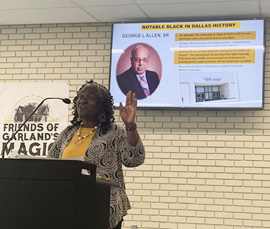Emphasizing “Blacks in Dallas history, not Black Dallas history,” Lenora Casmore told a Garland audience that “if we don’t tell stories rightfully, who’s going to tell it?” Casmore, a charter member of Remembering Black Dallas Inc., then took attendees on a verbal and pictorial tour of Dallas of an earlier day—immediate post-Civil War when newly freed individuals were establishing homes and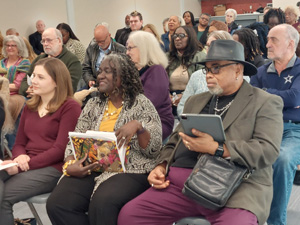 neighborhoods.
neighborhoods.
Speaking at the Annual Meeting of Friends of Garland’s Historic Magic 11th Street, Casmore outlined some of the more prominent area Freedmen’s towns–such as the 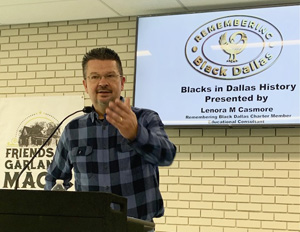 neighborhood of “State Thomas,” also called “Short North Dallas,” where Uptown is now. “It was like Highland Park for African Americans” with many professionals such as doctors, lawyers and dentists. These were people of means, not just off the plantation, who had been freed longer than just in 1865.
neighborhood of “State Thomas,” also called “Short North Dallas,” where Uptown is now. “It was like Highland Park for African Americans” with many professionals such as doctors, lawyers and dentists. These were people of means, not just off the plantation, who had been freed longer than just in 1865.
She mentioned Deep Ellum as another Freedmen’s town. Casmore described it as the first non-segregated area in Dallas because it attracted both African Americans and persons of European descent. Henry Ford picked Deep Ellum as the site for one of his earliest Model T auto plants. She also said Deep Ellum was always a place of music and socializing, as it is today. 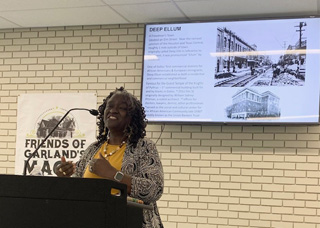
Deep Ellum includes the historic Grand Temple of the Knights of Pythias, designed by noted Black architect William Sidney Pittman. Pittman was married to the daughter of Booker T. Washington. From 1916 to 1939, the Knights of Pythias Temple served as the social, professional and cultural center of the African American community.
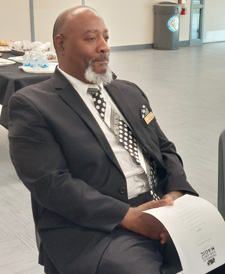 At the Feb. 18 presentation, Casmore also described Joppa (Joppee) in Oak Cliff, off I-45 near Loop 12, as one of the best Freedman communities in the United States that remains intact. In addition, it was the site of the first Juneteenth festivities in Dallas.
At the Feb. 18 presentation, Casmore also described Joppa (Joppee) in Oak Cliff, off I-45 near Loop 12, as one of the best Freedman communities in the United States that remains intact. In addition, it was the site of the first Juneteenth festivities in Dallas.
Casmore also explained that newly freed enslaved persons purchased more land in the Upper and Lower White Rock communities than in any other part of Dallas County. 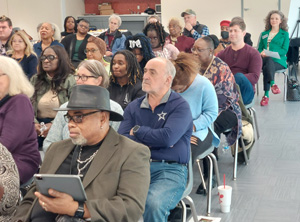
The Freedman’s Cemetery memorial at Lemmon and Central Expressway in Dallas commemorates the African American graves that were demolished with the incoming construction of Central Expressway. The Freedman’s Cemetery was established as a burial ground for Dallas’ early African American population in 1861. This was one of the largest Freedman Cemeteries in the country.
She urged guests to visit the Bear Creek community on the outskirts of Irving, established by former enslaved person Jim Green and one of the oldest freedmen communities in Texas. The Jackie Townsell Bear Creek Heritage Center on the grounds helps preserve this history.
Casmore also focused on outstanding Dallasites. She said that “there were Thurgood Marshalls and MLK’s all over the place” in the early Black community. She mentioned George L. Allen Sr., for whom the George L. Allen courts building in Dallas is named and said that most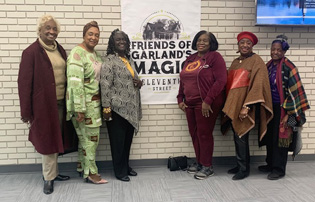 people don’t realize Allen was Black. He attended the University of Texas until he was dismissed when it was discovered that he was Black. Additionally, he was the first African American elected to the Dallas City Council.
people don’t realize Allen was Black. He attended the University of Texas until he was dismissed when it was discovered that he was Black. Additionally, he was the first African American elected to the Dallas City Council.
Others she highlighted included:
- L. Turner, first Black native Dallasite to practice law in Dallas
- Marcellus Clayton Cooper, of Dallas, was first black dentist in Texas.
- Fannie C. Harris, a Black pioneer teacher for one of the first African American high schools in Dallas, taught in Dallas for of 62 years.
Casmore dedicated her talk to “all our African and African American ancestors who helped make Dallas County into the city that we see and enjoy today.”
Information and photos submitted by Kay Moore.


